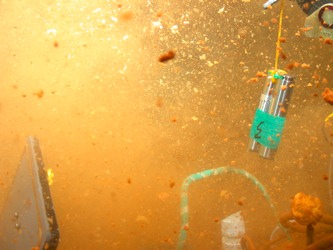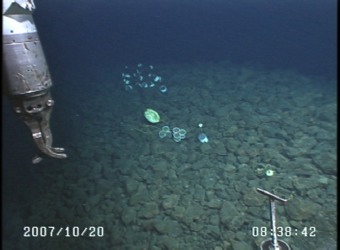FeMO2 Dive Cruise 2007
Report Day 09 -- Friday 19 October 2007 -- A Lonely Anglerfish
FeMO2 Dive Cruise 2007 |
| Daily Reports 0 | 1 | 2 | 3 | 4 | 5 | 6 | 7 | 8 | 9 | 10 | 11 | 12 | 13 | 14 | 15 | 16 |
After breakfast a CTD cast is made, followed by recovery of the deep-sea elevator with its cargo of samples. Jason is put back in the water soon after noon to dive on Pele's Pit once again. This is dive number 312.

Shortly after Jason reaches the bottom a round gray fish is found sitting on the seafloor. It looks similar to a puffer fish in shape but has an enormous mouth with thick fish lips and a head so round that the eyes face forward. It looks almost human. Anthony is smitten with her appearance and names her Angelina Jolie. (Clearly Anthony has been at sea too long.) The fish has a little nose from which 2 thin filaments project. It also has short flaps projecting from all around the head. A look in a book reveals that it is a type of anglerfish called a "goosefish". Anglerfish are called "anglers" because they actually fish with the filaments on their nose. The end of the filament has a fleshy extension that might look like a tempting morsel with which the angler can lure smaller fish to swim close. Below the filament and lure is an enormous mouth ready to slurp up any little fish that investigate. Anglerfish camouflage themselves then stick out their lure and wait for lunch. Some anglerfish are reported to grow to 1.5 meters (5 feet) in length.
Deep-sea anglers have several remarkable adaptations to life in the deep ocean where there is no light and food is scarce. Their lure, the fleshy tempting morsel at the end of the filament, glows in the dark making it more visible to potential prey. They also have, like many deep ocean fish, an extremely expandable stomach so they can swallow prey as nearly as large as they are. Deep-sea anglerfish also have extreme sexual dimorphism - the two genders look completely different. The female can be 10 times as large as the male and he has no lure with which to feed himself. Because of the darkness the male and female find each other by sense of smell. When the male finds the female he bites her through the skin of her pelvic region and doesn't let go. Eventually their circulation systems will join. Unable to swim on his own or even to feed himself he shrivels up until he is just a parasitic sperm sack totally dependent on the female. Most women seem to know a male like this.
Angelina the anglerfish is an ambush predator and stands her ground when approached by Jason. The pilot waves the manipulator in front of her face - still no response. The pilot gets closer until the manipulator just brushes her two alluring filaments and Angelina turns and darts into the darkness away from Jason's lights.

Perhaps the most remarkable thing about seeing this anglerfish is that it is just about the only large organism we have seen. The other large organisms include a few slender gray eels that look to be about 30 cm (1 foot) long, a shrimp about 10 cm long and a couple of annelid worms about 3 cm long. The anglerfish is a monster among these smaller creatures. Other animals are tiny or invisible. The seafloor looks barren because there is no kelp or seaweed or eel grass that you find along sunlit shores. There are no plants in the cold dark ocean. Yet this place is anything but lifeless. Microbial life is everywhere, on rocks, around vents and between pillow lavas. Most of these microbes are bacteria and Craig Moyer tells me that up to 10% of the microbes at Lo'ihi are Archea. The FeMO group also has cultured some fungi, mostly single celled yeasts, but it is not clear at this stage how abundant these eukaryotes are. Future work will tell, but it is clear that all three major domains are represented eukaryotes, bacteria and archea.

It is possible that some of the mats we see are mostly mineral. Iron oxidizing microbes must extrude the oxidized iron, which is insoluble and sticks together due to polysaccharides extruded with it. There are also soft minerals that form by hydrothermal alteration of rock. But the sites we have visited on Lo'ihi are known to harbor microbes - it is why the scientists are here. Bacteria of several types have been cultured from the mats. Microbial DNA has been extracted from mats samples. Experiments to characterize their metabolism are going on in the laboratories of the Kilo Moana and ashore.
In places the mats are at least 40 cm thick. They can be so deep that the electrochemistry probe has been entirely buried in microbial mat. Bacteria are only 1/100 to 1/10 the diameter of human cells. This makes them one thousand to one million times smaller (volumetrically and by mass) than human cells - yet they build mats that cover acres and are deeper than any mud puddle. This seems a nearly impossible quantity of bacteria. Some mats don't even look like microbial mats - the "moon mat" from near Ula Nui (at 5,000 meters depth) is huge and covered by a crust of manganese below which occurs a thick layer of soft squishy yellow bacteria. Up in Pele's Pit much of what looks like rusty rock in still photos, wiggles like jello in the videos - it's all bacteria. When Jason accidentally stirs up a mat, filamentous clumps of it drift through the water like a snowstorm. This is a bacteria dominated ecosystem. What seems remarkable is that I can see no organisms that are obviously grazing on the mats.
The sheer abundance of these iron-oxidizing microbes at Lo'ihi is remarkable. But Lo'ihi may not be exceptional, it has been chosen as a study site because its chemical and physical environments represent much of the rest of Earth. Lo'ihi is just one of perhaps 100,000 seamounts worldwide. These seamounts sit on oceanic crust (i.e. iron-rich basalt) that covers something like 2/3rds of the Earth's surface. The microbial abundance of Lo'ihi may be found throughout the ocean basins and until recently the global importance of these microbes has not been appreciated. The fact that they get their energy from Earth's chemical species, and not the sun suggests, that older estimates of biomass based on photosynthesis at the Earth's surface may underestimate Earth's biomass and annual biomass production. New accounting that includes chemosynthesis may result in higher biomass production numbers.
This dive into the Pit of Death uses the electrochemistry probe coupled with a tripod that precisely positions the probe over the surface and pushes it into the mat incrementally. As the probe is pushed into the mat the measured concentration of chemicals such as iron, oxygen and hydrogen sulfide are recorded in the Jason control van. The changing concentration of a chemical with depth can be used to estimate the flow of it into or out of the mat - in other words how quickly the chemical is produced or consumed.
The dive ends at Pisces Peak, the summit of Lo'ihi 960 meters below sea level. The peak is steep sided with a small summit area. It looks like a pile of rubble that has been left at the base of a cliff, not a summit erupted from a volcano. Apparently it is all that remains from the higher summit destroyed during the 1996 eruption. Jason is recovered at midnight.
| FeMO2 Cruise Home Page |